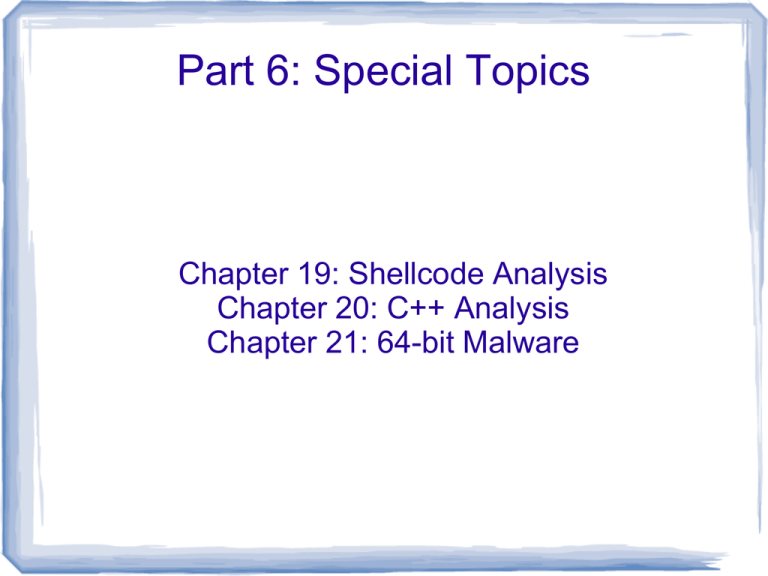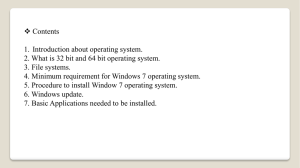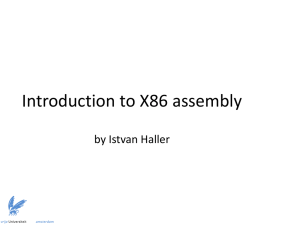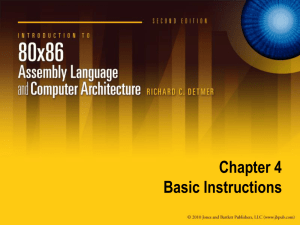IP? - The Fengs
advertisement

Part 6: Special Topics Chapter 19: Shellcode Analysis Chapter 20: C++ Analysis Chapter 21: 64-bit Malware Chapter 19: Shellcode Analysis Shellcode Analysis 1. Position-Independent Code 2. Identifying Execution Location 3. Manual Symbol Resolution 4. Shellcode Encodings 5. NOP Sleds 6. Finding Shellcode Shellcode Analysis Shellcode Payload of raw executable code that allows adversary to obtain interactive shell access on compromised system Often used alongside exploit to subvert running program Issues to overcome Getting placed in preferred memory location Applying address locations if it cannot be placed properly Loading required libraries and resolving external dependencies 1. Position-Independent Code No hard-coded addresses All branches and jumps relative Code can be placed anywhere in memory and still function as intended Essential in exploit code and shellcode being injected from a remote location since addresses are not necessarily known Table 19-1 2. Identifying Execution Location Shellcode may need to find out its execution location x86 does not provide EIP-relative access to embedded data as it does for control-flow instructions Must load EIP into general purpose register Problem: “mov eax,eip” not allowed Two methods call/pop • call pushes EIP of next instruction onto stack, pop retrieves it (Listing 19-1) • stores 28-byte structure of FPU state to memory • FPU runs parallel to CPU, so must be able to accurately identify faulting instruction • fpu_instruction_pointer = EIP of last instruction that used FPU (Listing 19-2, 19-3) fnstenv 3. Manual Symbol Resolution Shellcode can not use Windows loader to ensure libraries are in process memory Must dynamically locate functions such as LoadLibraryA and GetProcAddress (both located in kernel32.dll) Finding kernel32.dll in memory Undocumented structure traversal (Figure 19-1, Listing 19-4) Parsing kernel32.dll PE Export Data Addresses of exported calls in header (relative virtual addresses in IMAGE_EXPORT_DIRECTORY AddressOfFunctions, AddressOfNames, AddressOfNameOrdinals arrays (Figure 19-2) To make shellcode compact, hashes of function names used to compare (Listing 19-6) 4. Shellcode Encodings Many exploits target unsafe string functions strcpy, strcat strcpy( buffer, argv[1] ); Injection of malicious code must avoid NULL bytes which will terminate buffer overflow pre-maturely (Listing 19-8) Example mov eax, 0 ; 4 bytes of NULL xor eax, eax ; No NULL bytes ASCII armor Hardens against buffer overflow If exploit requires injection of addresses, then force addresses to include NULL by putting all code/data within ASCII armor at beginning of address space 5. NOP Sleds Sequence of NOPs preceing shell code Address targeting inexact Allows exploit to increase likelihood of hits by giving a range of addresses that will result in shellcode executing Buffer[0..256] Shell Code [stuff] Return addr New New Addr Addr [stuff] New New Addr Addr 5. NOP Sleds NOP NOP NOP NOP NOP IP? IP? NOP NOP NOP IP? NOP NOP NOP NOP IP? xor eax, eax NOP mov al, 70 NOP xor ebx, ebx NOP xor ecx, ecx xor eax, eax int 0x80 mov al, 70 jmp short two xor ebx, ebx xor ecx, ecx one: Shell Code pop ebx int 0x80 xor eax, eax jmp short two one: mov [ebx+7], al mov [ebx+8], ebx pop ebx mov [ebx+12], eax xor eax, eax mov al, 11 Shell Code mov [ebx+7], al lea ecx, [ebx+8] mov [ebx+8], ebx lea edx, [ebx+12] mov [ebx+12], eax int 0x80 mov al, 11 two: call one db '/bin/shXAAAABBBB' lea ecx, [ebx+8] lea edx, [ebx+12] int 0x80 two: call one db '/bin/shXAAAABBBB' 6. Finding Shellcode In Javascript Binary instructions encoded via unescape%u1122%u3344%u5566%u7788 = 22 11 44 33 55 66 88 77 In payloads Common API calls (VirtualAllocEx, WriteProcessMemory, CreateRemoteThread) Common opcodes (Call, Unconditional jumps, Loops, Short conditional jumps) In-class exercise Lab 19-02 In IDA, find the code that opens the registry to find the default web browser Find the code that attempts to create a new web browser process Find the place in the code where the browser process is opened and the malicious payload is injected into it and run In OllyDbg • Set a breakpoint in main and single step (F8). What happens? • • • View the buffer containing the shellcode to be injected into the browser (address was found in IDA Pro) – In OllyDbg code pane, right click to “Go to” address – Set origin to address and run Generate Listing 19-4L Use the remaining time to attempt to complete the shellcode analysis. Where does your analysis get blocked? In-class exercise Lab 19-03 Run strings on the PDF file to generate Listing 19-11L Implement the Python script in Listing 19-12L and generate the shellcode. Does it differ from the included code? Load shellcode_launcher.exe into IDA Pro or Olly • Set arguments to point to match command line shown below Listing 19-12L. Find where the shellcode has been loaded and will be launched • Set a breakpoint just before the launch of the shellcode and single-step *into* the call • Where has the code been loaded? Generate Listing 1913L with these run-time addresses • Single-step through to find the loop that populates the kernel32 API calls Chapter 20: C++ Analysis C++ Analysis 1. Object-Oriented Programming 2. Virtual vs. Nonvirtual Functions 3. Creating and Destroying Objects 1. Object-Oriented Programming Functions (i.e. methods) in C++ associated with particular classes of objects Classes used to define objects Similar to structs, but also include functions “this” pointer Implicit pointer to object that holds the variable being accessed Implied in every variable access within a function that does not specify an object Passed as a compiler-generated parameter to a function (typically the ECX register, sometimes ESI) “thiscall” calling convention (compared to stdcall, cdecl, and fastcall calling conventions) Listing 20-2, Listing 20-3 1. Object-Oriented Programming Overloading and Mangling Method overloading allows multiple functions to have same name, but accept different parameters When function called, compiler determines which version to use (Listing 20-4) C++ uses name mangling to support this construct in the PE file Algorithm for mangling is compiler-specific IDA Pro demangles based on what it knows about specific compilers 2. Virtual vs. Nonvirtual Functions Virtual functions Can be overridden by a subclass (polymorphism) Execution is determined at runtime with the child subclass overriding the parent Can keep parent functionality by changing the type of the object to be an instance of the parent class Nonvirtual functions Execution is determined at compile time If object is an instance of the parent, the parent class's function will be called, even if the object at run-time belongs to the child class Table 20-1 2. Virtual vs. Nonvirtual Functions Implementation Nonvirtual functions the same Polymorphism via virtual function tables (vtables), effectively an array of pointers to code (Table 20-2) • Should point to legitimate subroutines in IDA Pro (sub_####) (Listing 20-6) • Switch tables similar but point to legitimate code locations within code in IDA Pro(loc_#####) Virtual functions do not use “call” instruction • Code xrefs within IDA Pro do not resolve into “calls” Vtable similarity can be used to associate objects • Listing 20-7 3. Creating and Destroying Objects Constructor and Destructor functions Object either stored on stack for local variables Object stored in heap if “new” is used Note: Implicit “deletes” for objects that go out of scope may be handled as exceptions Listing 20-8 • Initializes vtable for object stored on stack • Creates another object via “new” call (note the name mangling) In-class exercise Lab 20-1 In IDA Pro, what does the first subroutine called in WinMain do? What does the instruction at 0x0401019 do? What does the instruction at 0x040101C do? Follow the second subroutine call. What does it do? What does the instruction at 0x0401055 do? Chapter 21: 64-bit Malware 64-bit Malware 1. Why 64-bit Malware? 2. Differences in x64 architectures 3. Windows 32-Bit on Windows 64-Bit 4. 64-Bit Hints at Malware Functionality 1. Why 64-bit Malware? AMD64 now known as x64 or x86-64 Similar to 32-bit x86 with quad extensions Not all tools support it Most malware still 32-bit Backwards compatibility support for 32-bit ensures that 32bit malware can run on both 32-bit and 64-bit machines Reasons for 64-bit malware Kernel rootkits must be 64-bit for machines to run on a 64-bit OS Malware and shellcode being injected into a 64-bit process must be 64-bit 2. Differences in x64 Architecture 64-bit vs. 32-bit x86 All addresses and pointers 64-bit All general purpose registers 64-bit (RAX vs. EAX) Special purpose registers also 64-bit (RIP vs. EIP) Double the general purpose registers (R8-R15) • R8 = 64-bits • R8D = 32-bit DWORD • R8W = 16-bit WORD • R8L = 8-bit LOW byte RIP-relative data addressing (Listing 21-2 vs. Listing 21-3) • Recall “call/pop” needed previously to get location of data attached to exploit code • Allows compiler to easily generate position-independent code • Decreases the amount of relocation needed when code/DLLs are loaded • Without call/pop, it is much harder to identify exploit code 2. Differences in x64 Architecture 64-bit vs. 32-bit x86 Calling convention and stack usage • Similar to “fastcall” • First four parameters passed in RCX, RDX, R8, and R9 • Additional parameters passed on stack • Hand-coded malware may completely deviate from this convention to confuse analysis • Stack space is allocated at beginning of function call for the duration of the call (i.e. no push/pop within function) (Figure 21-1) • Microsoft's 64-bit exception handling model assumes a static stack • Reverse engineering complicated since local variables and function parameters co-mingled (Listing 21-4 vs 21-5) 2. Differences in x64 Architecture 64-bit vs. 32-bit x86 Leaf and Nonleaf Functions • Functions that call other functions are non-leaf or frame functions as they require a frame to be allocated • Nonleaf functions required to allocate at least 0x20 bytes of stack space when calling another function to save register parameters (local variables bump allocation beyond 0x20) 64-Bit Exception Handling • For 32-bit, SEH handling uses stack • For 64-bit, static exception information table stored in PE file and stored in .pdata section per function. (Does not use stack) 3. Windows 32-Bit on Windows 64-Bit WOW64 subsystem allows 32-bit Windows to run on 64-bit Windows Redirects accesses to C:\Windows\System32 to C:\Windows\WOW64 So if 32-bit malware running on 64-bit Windows writes a file to C:\Windows\System32, it shows up in C:\WINDOWS\WOW64 Similar redirection for registry keys 32-bit malware wishing to “break-out” of WOW64 to infect 64-bit system can disable redirection (IsWow64Process, C:\Windows\Sysnative, Wow64DisableWow64FsRedirection to disable for a thread) 4. 64-Bit Hints at Malware Functionality 64-bit shortcuts Integers often stored in 32-bit values Pointers are always 64-bit Can differentiate non-pointers from pointers via size of register used (Table 21-1)








